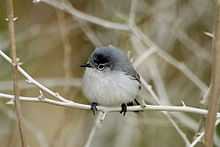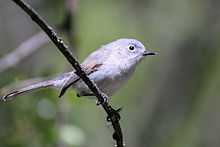Blue-gray Gnatcatcher
| Blue-gray Gnatcatcher | |
|---|---|
 | |
| Conservation status | |
| Scientific classification | |
| Kingdom: | Animalia |
| Phylum: | Chordata |
| Class: | Aves |
| Order: | Passeriformes |
| Family: | Polioptilidae |
| Genus: | Polioptila |
| Species: | P. caerulea |
| Binomial name | |
| Polioptila caerulea (Linnaeus, 1766) | |
The Blue-gray Gnatcatcher (Polioptila caerulea) is a very small songbird.

This gnatcatcher species measures 10–13 cm (3.9–5.1 in) and weighs only 5–7 g (0.18–0.25 oz).[2][3] Adult males are blue-grey on the upperparts with white underparts and have a long slender bill, long black tail and an angry black unibrow. Females are less blue without the unibrow. Both sexes have a white eye ring.
Their breeding habitat includes open deciduous woods and shrublands in southern Ontario, the eastern and southwestern United States, and Mexico. Among gnatcatcher species, this is in the only one to breed in Eastern North America. They build a cup nest similar in construction to a hummingbird nest on a horizontal tree branch. Both parents construct the nest and feed the young; they may raise two broods in a season.
These birds migrate to the southern United States, Mexico, northern Central America-(Belize, Guatemala, and Honduras), Cuba, Bahamas, Turks and Caicos Islands, and the Cayman Islands.
They forage actively in trees or shrubs, mainly eating insects, insect eggs and spiders. They may hover over foliage (gleaning), or fly to catch insects in flight (hawking).
The tail is often held upright while defending territory or searching for food.
References
- ↑ BirdLife International (2012). "Polioptila caerulea". IUCN Red List of Threatened Species. Version 2013.2. International Union for Conservation of Nature. Retrieved 26 November 2013.
- ↑
- ↑
External links
| Wikimedia Commons has media related to Polioptila caerulea. |
- Blue-gray Gnatcatcher - Polioptila caerula - USGS Patuxent Bird Identification InfoCenter
- Blue-gray Gnatcatcher Species Account - Cornell Lab of Ornithology
- Blue-grey Gnatcatcher stamps (with RangeMap)-Turks and Caicos
- Blue-grey Gnatcatcher videos on the Internet Bird Collection
- Blue-gray Gnatcatcher photo gallery VIREO
- Blue-gray Gnatcatcher Bird Sound
